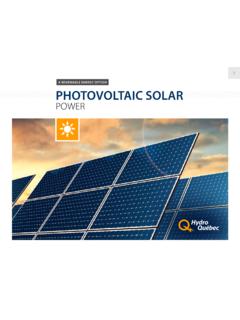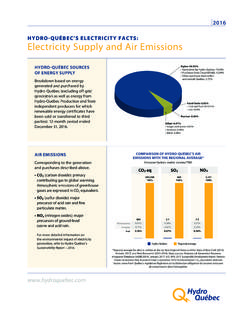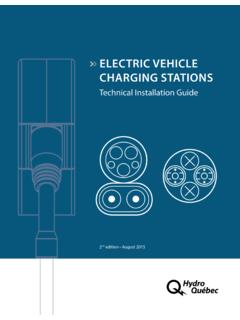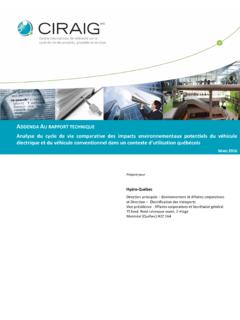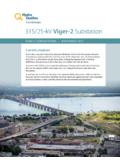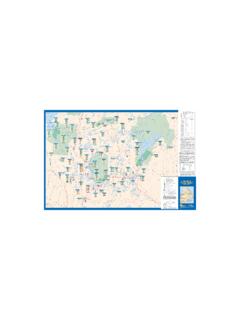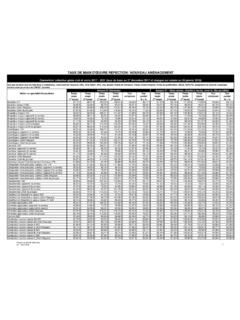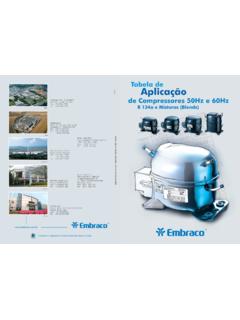Transcription of Environmental Effects Studying Net Evaporation from the ...
1 Lakes, rivers, wetlands and forests are part of the Earth s freshwater cycle. Water and energy are intricately linked and are two major necessities for modern civilizations. As population increases, the demand for water and energy is growing rap-idly, creating challenging situations in a context where freshwater is a scarce resource in many regions. In the , the energy sector is the largest user of water, accounting for about 50% of the total water withdrawals the past decade, Environmental footprints increasingly have been used to indicate human impact on the environment,2 with the water foot-print receiving much attention. There is an emerg-ing debate about whether hydroelectric generation is a significant consumer of water through the Evaporation process.
2 Evaporation or evapotranspi-ration (transfer of moisture from the earth to the atmosphere by Evaporation of water and transpira-tion from plants) varies regionally and is affected by several parameters relative air humidity, air and water temperature, solar radiation, water sur-face area, wind velocity and vegetation data available regarding the water foot-print of hydropower complexes only accounts for gross Evaporation estimated using traditional ,3 In many cases, gross Evaporation from reservoirs is considered water consumption, and if associated with a water consumption tax, it would increase the hydropower operation cost. Therefore, an adequate method to evaluate net Evaporation is necessary. Net Evaporation is the Evaporation associated with the reservoir minus the evapora-tion and evapotranspiration that occurred from the natural systems before flooding.
3 For governments and the energy sector, the evaluation of net evapo-ration from hydroelectric reservoirs is becoming more and more relevant to ensure that methods of energy generation are compared adequately in terms of the water article presents the net water Evaporation of a reservoir (Eastmain-1) based on comprehen-sive field data. This is a world-first research project and revealed that the Eastmain-1 reservoir net Evaporation is close to description and methodologyThe Eastmain-1 Reservoir is in the boreal ecore-gion of Quebec, Canada, about 800 km north of Montreal. The Eastmain River watershed is domi-nated by coniferous forest and shallow podzolic and peat soils developed over igneous bedrock and quaternary sediments.
4 Aquatic systems are described as oligotrophic characterized by a low water nutrient concentration, supporting a sparse growth of algae and other organisms, and having a high oxygen content, with overall low production of algae and 160-MW Eastmain-1 powerhouse was commissioned in 2006. The main dam and 33 dikes form the Eastmain-1 Reservoir, with a sur-face area of 603 km2. Another 768 MW of capacity were added in 2012 with the construction of the Eastmain-1-A powerhouse, yielding a total energy output from the Eastmain-1 Reservoir of about TWh per year (from 2012 forward). As part of the Eastmain-1-A and Rupert diversion project, a portion of the water from the Rupert River was diverted to the Eastmain-1 hydrology of the Eastmain-1 Reservoir watershed (25,857 km2) reflects the regional cli-mate; runoff is strongly seasonal, with high flows in the spring (peaking in May or June) and low flows in late winter.
5 The reservoir is covered with ice about 180 days per year. The water discharged from Eastmain-1 will flow into the Opinaca By Alain Tremblay, Simon Tardif, Ian B. Strachan and Christian TurpinAlain Tremblay, PhD, is a senior environment advisor manager of the greenhouse gas research program and Simon Tardif, PhD, is a hydrometeorologist with Hydro-Quebec Production (Generation). Ian Strachan, PhD, is associate professor of micrometeorology at McGill University. Christian Turpin, , is an environment advisor with Net Evaporation from the Eastmain-1 ReservoirA first-of-its-kind study of net Evaporation at a hydroelectric facility reveals that the project has very little effect on the loss of water to the atmosphere as compared with pre-impoundment EffectsThis article has been evaluated and edited in accordance with reviews conducted by two or more professionals who have relevant expertise.
6 These peer reviewers judge manuscripts for technical accuracy, usefulness, and overall importance within the hydroelectric to be used at the new 138-MW Sarcelle powerhouse and again at the 5,616-MW Robert-Bourassa and 1,436-MW La Grande-1 generating stations. To reduce the impact of the project on the Rupert and Lemare rivers, mitiga-tion measures were put in place. Eight weirs were built on the Rupert River to maintain the water level for different uses of the river (such as navigation and fish spawning areas), and an ecological instream flow that reproduces the mean annual natural hydrological cycle on both rivers is of water evaporationIn an Eastmain-1 Reservoir net green-house gas emissions project ( ) that was carried out4,5 over seven years, many parameters were measured, including energy fluxes.
7 Eddy covariance systems were used to measure Evaporation from the reservoir and evapotranspiration from forests and wetlands. The exchange of water vapor measured does not discriminate between Evaporation or transpiration. For simplic-ity, the measured water exchange is called evapotranspiration, with the understand-ing that such exchange from a purely aquatic system is Evaporation . Details on the eddy covariance technique, equations and calculations are We used the standard procedures employed by the flux community in applying the eddy covariance natural aquatic ecosystem is divided into three categories: rivers, lakes and streams. The Eastmain River rep-resents the dominant component in the region, with 82 km2 (55%) of the total aquatic surface area.
8 Up to 827 lakes were contained within the flooded lands, with areas of 100 m2 to 10 km2, accounting for 45% of the total aquatic surface. More than 827 streams of various widths and lengths, from only 10 m up to km and totaling km2, represent the smallest component (less than 1%) of the natural aquatic natural terrestrial ecosystem is divided into wetlands and forests. The forest can be divided into three types: coniferous forest represents 167 km2 (49%) of the total terrestrial surface area, while deciduous forest and burned forest respectively represent 16 km2 (5%) and 114 km2 (33%) of the surface area. Wet-lands represent km2 ( ) of the total terrestrial was measured over forest, peatland and the Eastmain-1 Res-ervoir using three eddy covariance towers and meteorological stations.
9 Measure-ments were carried out from June 2006 to October 2012 at the forest and reser-voir sites. The eddy covariance tower on the peatland site was operated from June 2007 to October 2012. In this study, we used data from January 2008 to Decem-ber 2012 as they represent the most com-plete continuous data certain periods of the year (see Table 1), daily Evaporation or evapo-transpiration data were unavailable; mean values of the others years data were used to complete certain years. All towers were removed in October 2012, consequently monthly values for October, November and December 2012, and mean values of 2008 to 2011 period data were used to complete the 2012 dataset. Similar calcu-lations were done for January, February, March, April, May and December 2008 for the peatland site (see Table 1).
10 The annual regional evapotranspira-tion budget was calculated as the area-weighted sum of the evapotranspiration budget for each ecosystem measured. For lakes and rivers, we used reservoir mean monthly Evaporation values. We did not have a long-term representative burned forest site data set. The types of burns in the region vary. Burned lowland forested sites often had peat substrate and now resemble peatlands with shrubs and other vegetated cover. Other lowland burns are often on shallow mineral soil and, along with more complete burns, would have less evapotranspiration. To calculate a burned forest evapotranspiration budget, we consider that 50% of the surface area would have similar rates of evapotranspi-ration to the peatland (see Table 1).

